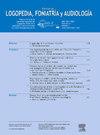Speech-in-noise recognition using a hearing test in Spanish: Data from a normal-hearing population
Q3 Nursing
引用次数: 0
Abstract
Background and objective
The Speech in Noise Test in Spanish (Prueba Auditiva de Habla en Ruido en Español, PAHRE) is a recently developed test not only measures speech reception thresholds in noise but also assesses the decline in intelligibility across various signal-to-noise ratio values.
The primary objective of this study was to evaluate the speech-in-noise recognition ability of normal-hearing subjects using this speech-in-noise test in Spanish. The relationship between age and speech recognition in environments with background is assessed, as well as the possible benefits of the Lombard effect for rehabilitation.
Material and methods
A total of 143 normal-hearing participants were categorized into five age groups (18–39, 40–49, 50–59, 60–69, >70 years). The participants underwent a comprehensive 30-min hearing assessment, which included a battery of audiological tests, with a particular focus on the Speech in Noise Test in Spanish.
Results
The results enabled the establishment of psychometric functions illustrating decreases in intelligibility across various signal-to-noise ratio values. Furthermore, reference values for speech-in-noise recognition thresholds were delineated for each age group.
Conclusion
The findings underscored the efficacy of test in assessing signal-to-noise ratio loss within the Spanish-speaking population, facilitating the comparison of age-related declines in speech-in-noise recognition. The results also highlight the potential advantages of incorporating the Lombard effect into speech-in-noise tests.
使用西班牙语听力测试识别噪音中的语音:来自听力正常人群的数据
背景和目的西班牙语噪声中的语音测试(Prueba Auditiva de Habla en Ruido en Español, PAHRE)是最近开发的一项测试,不仅测量噪声中的语音接收阈值,还评估各种信噪比值的可理解性下降。本研究的主要目的是利用西班牙语语音噪声测试来评估听力正常受试者的语音噪声识别能力。评估了年龄与背景环境下语音识别之间的关系,以及伦巴第效应对康复的可能益处。材料与方法143例听力正常者分为18-39岁、40-49岁、50-59岁、60-69岁和70岁5组。参与者接受了30分钟的全面听力评估,其中包括一系列听力学测试,特别关注西班牙语的噪音语音测试。结果建立了不同信噪比值下的可理解性下降的心理测量函数。此外,还为每个年龄组划分了噪声中语音识别阈值的参考值。结论本研究结果强调了该测试在评估西班牙语人群的信噪比损失方面的有效性,有助于比较年龄相关的噪音语音识别下降。研究结果还强调了将伦巴第效应纳入噪声语音测试的潜在优势。
本文章由计算机程序翻译,如有差异,请以英文原文为准。
求助全文
约1分钟内获得全文
求助全文
来源期刊

Revista de Logopedia, Foniatria y Audiologia
Nursing-LPN and LVN
CiteScore
1.10
自引率
0.00%
发文量
28
 求助内容:
求助内容: 应助结果提醒方式:
应助结果提醒方式:


